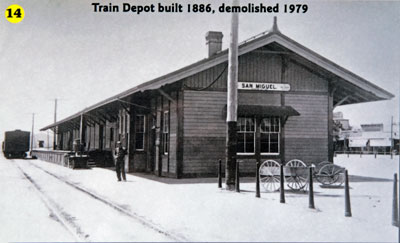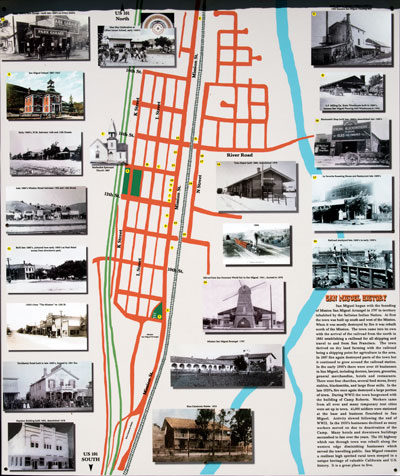National Register of Historic Places in San Luis Obispo County
Southern Pacific Railroad Depot
1300 Mission Street
San Miguel
Built 1886
Demolished 1979
We were unable to learn much about the Southern Pacific Depot in San Miguel, but we did find a photograph on a kiosk located at the Fremont Campsite in the 800 block of Mission Street.
According to a caption on the kiosk, the depot was listed on the National Register of Historic Places (NRHP) in 1978 and demolished in 1979. These dates suggest that concerned citizens were aware that the depot was threatened and had the building listed on the NRHP in an effort to save it.
This tactic has been common but largely futile. (The City of Paris building in San Francisco was a notable loss.) Listed buildings have no federal protection from modification or demolition although they may be granted some protection by state or local authorities.

The depot was located near the San Miguel Pioneers marker which has survived.

San Miguel History
(From the History Kiosk)
San Miguel began with the founding of Mission San Miguel Arcangel in 1797 in territory inhabited by the Salinian [sic] Indian Nation. At first the town was built up south and west of the Mission. When it was mostly destroyed by fire it was rebuilt north of the Mission.
The town came into its own with the arrival of the railroad from the north in 1885 establishing a railhead for all shipping and travel to and from San Francisco. The town thrived on dry land farming with the railroad being a shipping point for agriculture in the area.
In 1887 fire again destroyed parts of the town but it continued to grow around the railroad station. In the early 1900's there were over 40 businesses in San Miguel, including doctors, lawyers, groceries, general merchandise, hotels and restaurants. There were four churches, several feed stores, livery stables, blacksmiths, and large flour mills.
In the late 1920's, fire once again destroyed a large portion of town.
During WWII the town burgeoned with the building of Camp Roberts. Workers came from all over and many temporary tent cities were set up in town. 45,000 soldiers were stationed at the base and business flourished in San Miguel.
Activity slowed following the end of WWII. In the 1950's businesses declined as many workers moved on due to deactivation of the Camp. Many hotels and downtown buildings succumbed to fate over the years. The 101 highway which ran through town was rebuilt along the western edge diminishing businesses which served the travelling public.
San Miguel remains a resilient high spirited rural town steeped in a unique heritage of valuable California and U.S. history. It is a great place to live.

